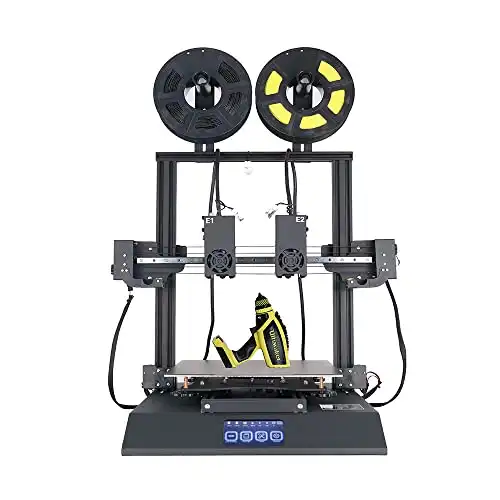
IDEX 3D printers don’t usually come cheap, but the Sovol SV04, Flashforge Creator Pro 2, and Tenlog TL-D3 Pro are three of the best low-cost dual extruder 3D printer printers challenging that idea.
All hovering around the $500 – $600 price range, they make dual color and dual filament printing more accessible than ever before.

It can be a challenge to pick which printer is going to best serve your needs, though. They all offer different printing experiences, including unique features that are difficult to add with DIY or upgrading.
We’ll go over the main pros and cons of each, plus add information on why certain features are good and who they cater to (ex. Newer hobbyists). By the end of it, you should have a better idea of what IDEX printer will serve your needs the best.
Without further ado, let’s dive in.
| Sovol SV04 | Flashforge Creator Pro 2 | Tenlog TL-D3 Pro | |
|---|---|---|---|
| Build Volume | 300 x 300 x 400 mm | 200 x 148 x 150 mm | 300 x 300 x 350 mm |
| Printer Footprint | 653 x 625 x 803 mm | 526 x 360 x 550 mm | 590 x 520 x 760 mm |
| Build Plate | Magnetic flexible plate | Aluminum | Borosilicate glass |
| Extruder Type | Direct Drive | Direct Drive | Direct Drive |
| Filament Compatibility | PLA, TPU, TPE, HIPS, ABS, PETG, Wood, PC, PA, PVA, ASA | ABS, PLA, PVA, HIPS | TPU, PVA, PLA, ABS, HIPS, PETG, Wood, most flexible filaments |
| Max Extruder Temp | 260°C | 240°C | 300°C |
| Max Bed Temp | 100°C | 120°C | 110°C |
| IDEX? | Yes | Yes | Yes |
| Enclosed? | No | Yes | No |
| Auto Bed-leveling? | Yes | No | No |
| Resume Print and Filament Sensor? | Yes | No | Yes |
| Touchscreen? | Yes | Yes | Yes |
| Connectivity | SD Card, Data Cable | SD Card | SD Card, USB |
| Price | $500 | $550 | $560 |
Sovol SV04 vs Flashforge Creator Pro 2 vs Tenlog TL-D3 Pro: A Quick Summary
Sovol SV04
- Price: Check latest price at Sovol 3D here / Amazon here
- Build volume: 300 x 300 x 400 mm
- Filament compatibility: PLA, TPU, TPE, HIPS, ABS, PETG, Wood, PC, PA, PVA, ASA
- Layer height: 100 – 400 microns
- Printing accuracy: ± 0.1 mm
- Max extruder temp: 260°C
- Max bed temp: 100°C
- Connectivity: SD Card, Data Cable
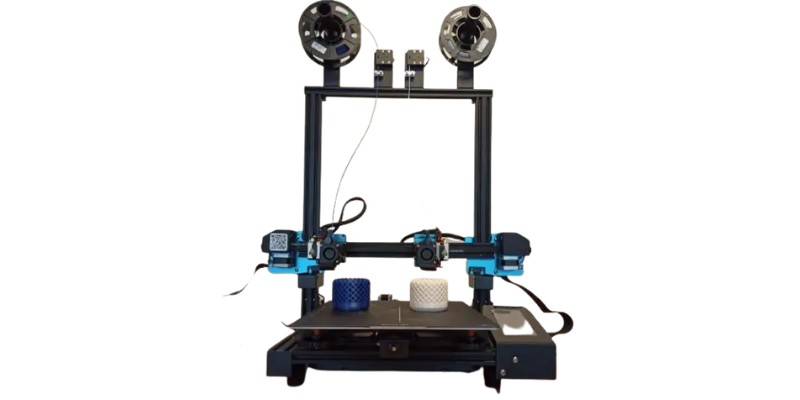
Sovol 3D’s foray into dual extruder printers is the SV04, a printer equipped with IDEX, a flexible magnetic plate, and a surprisingly large build volume for the price. It sounds great already, but let’s go over the exact specs.
The SV04 has a build volume of 300 x 300 x 400 mm. We wouldn’t quite consider this a large volume printer, but it certainly will have enough room for most hobbyists. It also has a max extruder temperature of 260°C and a max bed temp of 100°C.
It can handle a range of filaments, including PLA, TPU, TPE, HIPS, ABS, PETG, Wood, PC, PA, PVA, and ASA according to the store page. Although it’s true that most of these filaments should be pretty easy for the SV04, you might want to upgrade the nozzle to make the most out of harsher filaments like wood.
Despite the low price, we were impressed by the quality of life features that the SV04 has to offer. Not only is there the flexible magnetic plate, but it has auto bed-leveling, a filament sensor, and a touch screen.
If you don’t want to spend a lot but you want a lot in return, the SV04 is a solid option as far as IDEX printers go. We have a standalone review of the Sovol SV04 if you want more detail on its functionality.
Flashforge Creator Pro 2
- Price: Check latest price at Flashforge here / Amazon here
- Build volume: 200 x 148 x 150 mm
- Filament compatibility: ABS, PLA, PVA, HIPS
- Layer height: 100 – 400 microns
- Printing accuracy: ± 0.1 mm
- Max extruder temp: 240°C
- Max bed temp: 120°C
- Connectivity: SD Card
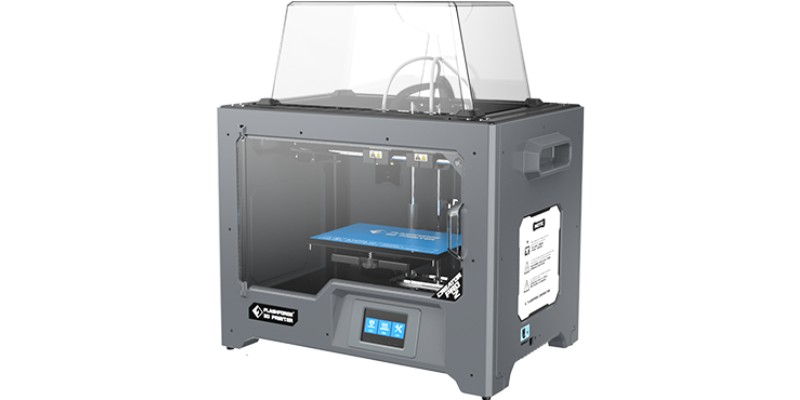
Unlike the original Creator Pro, Flashforge’s Creator Pro 2 uses direct drive IDEX to let you use multiple colors and filaments at the same time. It’s still ‘budget’ for an IDEX printer, but the low price didn’t stop Flashforge from giving the Pro 2 an enclosure.
Enclosed printers have superior temperature control, which can make them more newbie-friendly by reducing the likelihood of certain problems. But new or not, preventing issues like warping is a plus for any hobbyist.
You shouldn’t expect it to be a quiet printer, though– the Pro 2 tends to be loud despite the enclosed design. The drawbacks don’t stop there. It has a very high-cling aluminum build plate, which makes it a challenge to safely remove prints.
The Creator Pro 2 also doesn’t have as high of a maximum extruder temperature as the other printers we’re reviewing here: it peaks at 240°C and 120°C for the bed. The result is less access to the exciting filaments.
Another downside is that it has a build volume of only 200 x 148 x 150 mm (smaller than the Ender 3) and no auto-leveling or filament sensor. It might be hard to justify these feature deficits, even with the enclosure and touchscreen.
Ultimately, we think the Creator Pro 2’s enclosed IDEX design can really shine with some upgrades to the nozzle and print bed. It just requires a bit more care than some other options!
Tenlog Tl-D3 Pro
- Price: Check latest price Amazon here
- Build volume: 300 x 300 x 350 mm
- Filament compatibility: TPU, PVA, PLA, ABS, HIPS, PETG, Wood, most flexible filaments
- Layer height: 100 – 400 microns
- Printing accuracy: ± 0.1 mm
- Max extruder temp: 300°C
- Max bed temp: 110°C
- Connectivity: SD Card, USB
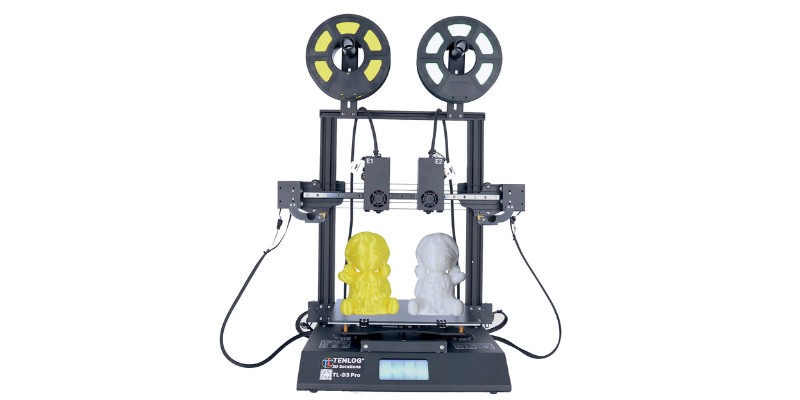
The Tenlog TL-D3 is the most expensive of these three printers, but not by much– and it has plenty to offer in return! Right off the bat, it can offer direct drive IDEX and a hefty build volume of 300 x 300 x 350 mm.
It also has a higher than usual maximum extruder temperature of 300°C and a max bed temperature of 110°C. This lets the TL-D3 Pro use a wonderful range of filaments including PVA, PLA, ABS, HIPS, PETG, Wood, TPU, and most other flexible filaments.
The Borosilicate glass build plate is a happy medium between the best options and the mediocre once. Glass plates have good adhesion, but don’t tend to be over the top like aluminum. They last a while, too!
Quality of life features on the TL-D3 Pro are a little hit or miss. It has a touch screen and filament sensor. On the flip side, it doesn’t have auto-leveling and certainly isn’t enclosed like the Creator Pro 2.
One of the best features of the TL-D3 isn’t related to the build volume, or its filament compatibility. Instead, the TL-D3 deserves praise for having linear rails on all three axes. These rails directly result in smooth, precise movements that are a benefit for any printer– but especially so for an IDEX printer.
This feature alone is enough to set the TL-D3 Pro apart from other dual extrusion printers. It’s safe to say that you should also think long and hard about passing up on the filament friendliness and feature richness that it offers.
Comparison Showdown
Build Volume
- Sovol SV04 – 300 x 300 x 400 mm
- Flashforge Creator Pro 2 – 200 x 148 x 150 mm
- Tenlog TI-D3 Pro – 300 x 300 x 350 mm

Although the Creator Pro 2 lags behind the others by a significant margin, the TI-D3 Pro and SV04 are actually very close in build volume. The greater z-axis on the SV04 may only be 50 mm, but it does have a lot of potential.
If you’re creating dual-color cosplay pieces or statuettes, prioritizing build volume isn’t a bad thing at all. That being said, the TI-D3 Pro could still be optimal because of other features.
The most important thing to keep in mind is that you won’t be satisfied with the Creator Pro 2 unless you only want to print very small objects. It will prove to be a disappointing investment if, down the line, you want more.
Enclosure
- Sovol SV04 – Not Enclosed
- Flashforge Creator Pro 2 – Enclosed
- Tenlog TI-D3 Pro – Not Enclosed
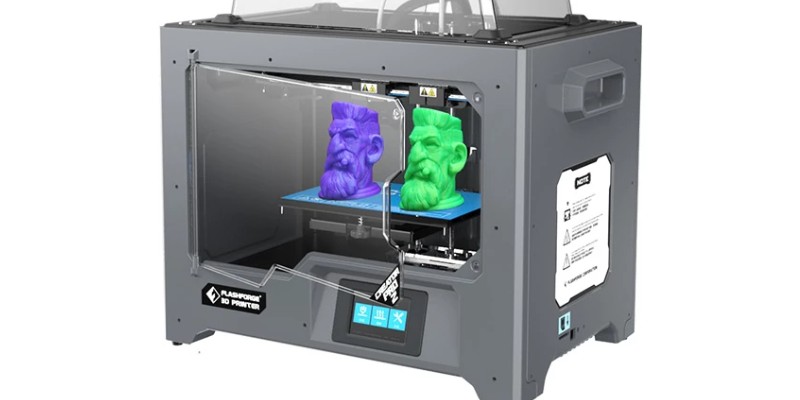
The small build volume might be excusable once you consider the Creator Pro 2 offers an enclosure. Enclosed designs are often saved for pricier printers, and they definitely make things easier.
There are two main benefits to an enclosure: they maintain an even, warm temperature around the print bed and they prevent airflow from entering the print area. These benefits help avoid problems like warping, but they also ensure stable outputs.
Even if you’re not making your 3D printing hobby into a full-on business, the consistency of an enclosed printer might be nice if you ever want to sell some of your pieces on Etsy.
Another very desirable side effect is that certain specialty filaments are easier to work with if you have an enclosure. In general, a stable environment means less troubleshooting and more fun prints.
Build Plate
- Sovol SV04 – Flexible magnetic plate
- Flashforge Creator Pro 2 – Aluminum
- Tenlog TI-D3 Pro – Borosilicate glass
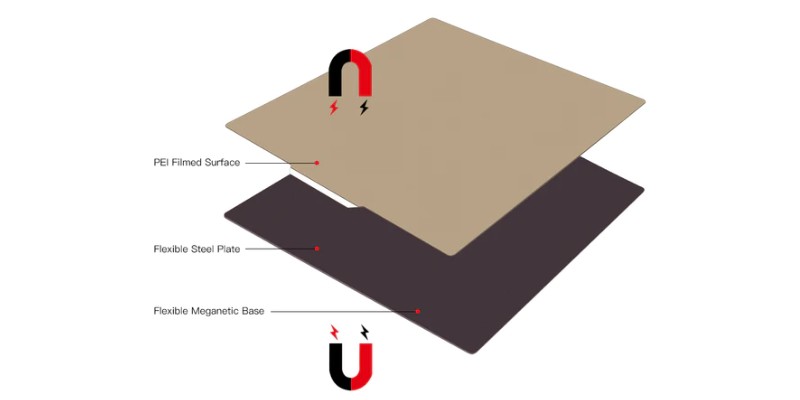
Out of the three, the SV04 has the best build plate even though it’s the cheapest. A flexible magnetic plate has pretty much everything. It’s easy to remove prints, still has good adhesion, and will last a long time. Removable plates also tend to be easier to clean and perform maintenance on.
The TI-D3 Pro’s borosilicate glass is a decent second option. It’s long-lasting and has good adhesion, but you’ll likely still use a scraper to get some prints off.
Glass is definitely better than the Creator Pro 2’s aluminum, though. Frankly, seeing an aluminum build plate at this price point is a disappointment. Aluminum tends to be difficult to work with since many prints will adhere to it too strongly to safely remove.
Filament Compatibility
- Sovol SV04 – PLA, TPU, TPE, HIPS, ABS, PETG, Wood, PC, PA, PVA, ASA
- Flashforge Creator Pro 2 – ABS, PLA, PVA, HIPS
- Tenlog TI-D3 Pro – TPU, PVA, PLA, ABS, HIPS, PETG, Wood, most flexible filaments
The TI-D3 Pro can work with the widest range of filaments, but the SV04 is a close second. Sovol advertises the SV04 as working with many, many filaments. They aren’t wrong, but the TI-D3 Pro can use all of those filaments, too.
Tenlog just doesn’t list PC, PA, PVA, TPE, and ASA on their product page. In fact, the TI-D3 might actually have more potential because the extruder can withhold higher temperatures of 300°C compared to the SV04’s 260°C.
As reflected by the list of usable filaments, the Creator Pro 2 is the most restrictive. Although it has an enclosed design, the aluminum build plate and the 240°C max extruder doesn’t do it any favors.
We expect the Pro 2 to have a much better range if you put in a little bit of effort and cash into making basic upgrades. The enclosure means it has the potential to work with finicky filaments like nylon, so long as the other parts are up to par.
Auto Bed-Leveling
- Sovol SV04 – Yes
- Flashforge Creator Pro 2 – No
- Tenlog TI-D3 Pro – No
The cheapest printer, the SV04, is the only one to have auto bed-leveling. It uses a copy of good old BL Touch to help with leveling.
Although it might seem like a meaningful strike against the Creator Pro 2 and the TI-D3 Pro, bed-leveling is more of a nice-to-have and not a need-to-have. Beds will likely come automatically leveled, and especially in the case of glass, are usually quite even already.
Auto-leveling doesn’t ensure that you’ll have no work to do or no issues will arise, either. All in all, it’s doubtlessly important; But auto leveling is not the end of the line.
Price
- Sovol SV04 – $500
- Flashforge Creator Pro 2 – $550
- Tenlog TI-D3 Pro – $560
The SV04 is the cheapest printer out of the bunch, which certainly makes it a tempting offer. It doesn’t have any crucial upgrades and it works fine out of the box. For those reasons, it wins when it comes to cost alone.
The TI-D3 Pro has key upgrades that make the extra $60 very worthwhile, though. It still has a decent build plate and a big build volume, and the linear rails make it truly special.
Actually, the Creator Pro 2 also has a unique feature that makes it worth the extra money with its enclosed design. Between the linear rails and the enclosure, it’s difficult to price out the “cost savings” on the SV04. These printers offer different things, pure and simple.
If we had to say, the Creator Pro 2 is the worst deal if only because of the cheap aluminum build plate. Even without upgrading anything else, getting a new flexible Flashforge build plate will run you at least $30.
Sovol SV04 vs Flashforge Creator Pro 2 vs Tenlog TL-D3 Pro – The Bottom Line
When it comes to out of the box functionality, the Tenlog TL-D3 Pro pulls ahead. We suggest purchasing the TL-D3 if you want the best non-enclosed, discount IDEX printer.
Although the SV04 is a solid choice (and is really quite similar in many ways), it’s edged out just slightly because of the TL-D3’s linear rails and higher extruder temperature tolerance.
Of course, it’s still fine to purchase the SV04 if the cost savings mean that much to you. We feel it could be a great option for new hobbyists, since it has auto-leveling and works fine for out of the box printing. The flexible build plate makes things even easier.
For the sake of stable, consistent printing, the Creator Pro 2 deserves a mention. It’s the obvious choice if you want an enclosed printer, as the only real choice for enclosed IDEX printers in this price range.
Unfortunately, the small build volume, subpar build plate, and mediocre filament compatibility make it a hard sell outside of that. The Pro 2 is for people who are interested in upgrading and don’t care about build volume, but not for extreme low-budgets or total newbies.



